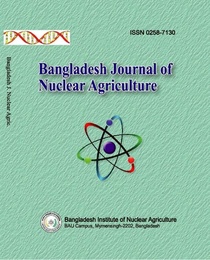YIELD PERFORMANCE OF RAPESEED MUTANTS AT M8 GENERATION
Abstract
To study the performances of rapeseed mutants based on seed yield and yield attributes experiments was conducted at various locations of Bangladesh. Analysis of variance showed highly significant variations among the mutants and check for most of the characters studied in individual location and combined over locations. Interaction between genotype and location also showed significant variations for all the agronomic traits. Mutant RM20 produce the highest plant height (101.1cm) and mature earlier than all other mutants. At BINA Sub-station farm Ishurdi and Magura all the mutant produce significantly higher number of siliquae plant-1 then parent BARI Sarisha-15 and check BARI Sarisha-17. RM-18 and RM-20 produce maximum seeds siliquae-1 (30) whereas; the mutant RM07 produced lowest number of seeds siliquae-1 (22). Combined means over locations showed that mutants namely RM-18 and RM-20 produced significantly higher seed yield (1551.1 and 1385 kg/ha, respectively). These two mutants had also higher number of siliquae than the mother variety. This suggests that gamma rays irradiation can be fruitfully applied to develop mutants with higher seed yield and other agronomic traits in oleiferous Brassica.
References
Ahloowalia, B. S., Maluszynski, M. and Nichterlein, K. 2004. Global impact of mutation derived varieties. Euphytica 135: 187–204. doi: 10.1023/B:EUPH. 0000014914.85465.4f.
Akter, S. E., Malek, M. A., Hossain, B. M., Akondo, R., I., Islam, M. and Bhuiyan, M. S. H. 2020. Selection of promising rapeseed mutants on the basis of morphology and yield attributes. Int. J. Chem. Studies 8(3): 2171-2174.
Ali, M. A., Bhuiyan, S. H., Rashid, M. H., Parveen, S., Robbani, M., G. and Sonom, M. 2016. Breeding for an ideal plant type in Brassica rapa L. Plant Knowledge J. 5(1) 2016: 36-43.
Amosova, A.V., Zoshchuk, S.A., Volovik, V. T., Shirokova, A. V., Horuzhiy, N. E. and Mozgova, G. V. 2019. Phenotypic, biochemical and genomic variability in generations of the rapeseed (Brassica napus L.) mutant lines obtained via chemical mutagenesis. PLoS ONE 14(8):221-229.
Barve, Y.Y., Gupta, R.K., Bhadauria, S.S., Thakre, R.P. and Pawar, S.E. 2009. Induced mutations for development of B. juncea canola quality varieties suitable for Indian agro-climatic conditions In: Induced Plant Mutations in Genomics Era. Food and Agriculture Organization of the United States, pp: 373–375.
BBS, 2019. Monthly Statistical Bulletin-Bangladesh. Bangladesh Bureau of Statistics. Statistics Division, Ministry of Planning, Government of the People’s Republic of Bangladesh. October 2019, p: 149.
Bhuiyan, M. S. H., Malek, M. A., Ikbal, M. F., Topu, A. and Alam, A. B. M. S. 2017. Parental line selection for yield contributing character of rice (Oryza sativa). Int. J. Agril. Res. Innov. & Tech. 7 (1): 46-50.
Bhuiyan, M. S. H., Malek, M. A., Sarkar, M. M. A., Islam, M. and Akram , M. W. 2019. Genetic variance and performance of sesame mutants for yield contributing characters. Malaysian J. Sustain. Agric. 3(2): 27-30.
Bus, A., Korber, R., Snowdon, R. and Stich, B. 2011. Patterns of molecular variation in a species-wide germplasm set of Brassica napus. Theor Appl Genet. 2011; 123: 1413–1423. https://doi.org/10.1007/s00122-0111676-7 PMID: 21847624
Channaoui, S., Idrissi, M. I., Mazouz, H. and Nabloussi, A. (2019). Reaction of some rapeseed (Brassica napus L.) genotypes to different drought stress levels during germination and seedling growth stages. Research Artical OCL 2019, 26, 23OCL 2019, 26, 23.
Delourme, R., Falentin, C., Fomeju, B. F., Boillot, M., Lassalle, G. and Andre, I. 2013. High-density SNP-based genetic map development and linkage disequilibrium assessment in Brassica napus L. BMC Genomics. 14: 120-130. https://doi.org/10.1186/1471-2164-14-120 PMID: 23432809.
Encylopaedia Britannica 2019. http://www. britannica.com/plant/brassica.
Gomez, K.A. and Gomez, A.A. 1984. Statistical Procedures for Agricultural Research. John Wiley and Sons, USA.
Hossain, M.S., Ashrafuzzaman, M., Malek, M.A., Mondal, M.M.A., Rafii, M.Y., Ismail M.R. and Islam, M.S. 2013. Evaluation and selection of tomato mutants for cultivation in summer. Res. Crops, 14(2): 546–550.
Jankowicz-Cieslak,J. and Till, B. J.(2015).“Forward and Reverse Genetics in Crop Breeding” in Advances in Plant Breeding Strategies: Breeding, Biotechnology and Molecular Tools, edt J. M. Al-Khayri, S. M. Jain, and D. V. Johnson (Vienna: Springer International Publishing), pp. 215–240. doi: 10.1007/978-3-319-225 21-0_8.
Mahmud, F., Rasul, M.G. and Rahim, M.A. 2008. Genetic diversity analysis in some advanced lines of Brassica napus. ScienceAsia, 34: 432–434.
Malek, M.A., Begum, H.A., Begum, M., Sattar, M.A., Ismail, M.R. and Rafii, M.Y. 2012a. Development of two high yielding mutant varieties of mustard (Brassica juncea (L.) Czern.) through gamma rays irradiation. Aust. J. Crop Sci., 6(5): 922–927.
Malek, M.A., Ismail, M.R., Monshi, F.I., Mondal, M.M.A. and Alam, M.N. 2012b. Selection of promising rapeseed mutants through multi-location trials. Bangladesh J. Bot., 41(1): 111–114.
Malek, M.A., Rafii, M. Y., and Khatun, M. K. 2016. Selection of rapeseed mutants for higher yield and yield contributing traits. J. Bangladesh Agril. Univ. 14(2): 141–146, 2016
Maluszynski, K. N., Zanten, L. V., and Ahlowalia, B. S. (2000). Officially Released MutantVarieties.TheFAO/IAEADatabase.MutationBreedingReview.Vienna: IAEA.doi:10.1111/pbi.12901.
Mondal, M. M. A., Malek, M. A., and Bhuiyan, M. S. H. (2018). The Role of Morpho-Physiological Attributes on the Seed Yield of Brassica juncea. Acta Sci. Agric. 2(5): 22-26.
Mondal M.M.A. and M. S. H. Bhuiyan. (2020). Morphological and reproductive characterization of developed mutants in groundnut. Int. J. Adv. Geosci. 8(1): 21-26.
Sharafi, Y., Majidi, M. M., Goli, S. H., Rashidi, F.2015. Oil content and fatty acids composition in Brassica species. Int. J. Food Prop. 2015; 18: 2145–2154. https://doi.org/10.1080/10942912.2014.968284.
Shah, S.A. and Rahman, K. 2009. Yield and growth response of rapeseed (Brassica napus L.) mutants to different seeding rates and sowing dates. Pak. J. Bot., 41(6): 2711–2716.
Tabassum, R., Malek, M. A., and Monshi, F. I. 2015. Assessment of Genetic Diversity of Rapeseed Mutants in Diverse Environments. Asian J. Agric. Res. 9 (6): 325-333.
Zhao, Y., Xiao, L. and Lu, C. 2009. Genetic analysis of yield and its components of B. napus hybrids using resynthesized rapeseed lines. Agric. Sci. China, 8(11): 1286–1292.
-
Download



